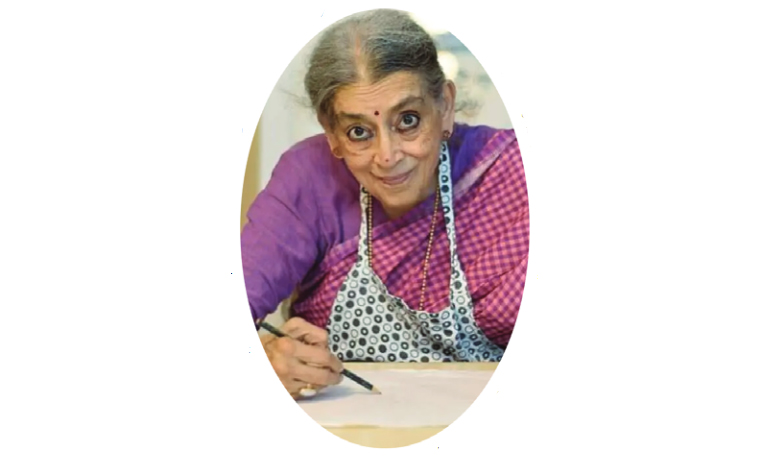A sensitive and self-taught artist
“Freedom that came too late, has come to me now. There is no age to love or to be loved. To make art you must have passion, you must fall in love and somewhere in the exuberance feel the pain of what love brings to life” – Lalita Lajmi
Indian painter Lalita Lajmi whose family included her brother, the Hindi film director, producer, and actor Guru Dutt; her late filmmaker daughter Kalpana Lajmi, and her cousin Shyam Benegal, a film director, was born in Calcutta (now Kolkata), West Bengal.
Lajmi developed interest in arts, and in 1960, participated in a Progressive Artists Group exhibition at the Artist’s Centre, Bombay. She had her first solo show a year later under the direction of her mentor K.H. Ara. To make ends meet, she taught for over 20 years at Campion and Convent of Jesus and Mary schools. Later, she enrolled in the J.J. School of Art to finish her Master’s degree in art. While teaching, she worked with disabled and underprivileged children.
Lajmi was primarily self-taught who lacked direction. Until late 1970s, her work was influenced by Indian films. Her initial works, shaped by her personal experiences and observations, were melancholic, whereas her later works were more upbeat.
She expanded into etchings, oils, and water colours by the mid-1980s, constantly reinventing herself. Her works depicted the hidden conflicts between men and women. However, her women were not docile but assertive, individualistic, and aggressive. She also portrayed the mother-daughter bond. Her flawless water colours typically told a multilayered history of the modern Indian woman, post-Independence. Her work majorly featured figurative characters – men, women, children, and clowns – that were strongly autobiographical, creating a visual biography, her viewers were free to interpret.
A seasonal artist, she didn’t let the pandemic slow her down, but used the resources at her disposal. With pencil, water colour, and crayon, two 21-footer long Japanese scrolls told stories about family, ageing, bonds, relationships, birds, flowers, hybrid animals, embryos, human anatomy and vertebrae. Lajmi used the sepia tone of the old scrolls’ tube as a foundation for her monochrome paintings.
Through psychoanalysis she had her dreams read and explained. To overcome her existential fears, she confronted them by painting surreal nightmares and fantasies. Lajmi’s works were exceptional in their capacity to address the complexities of our minds at a time when mental health issues were pressing and widespread.
Lajmi set up a press in her kitchen after completing a government-funded programme that taught intaglio and etching in evening classes at the Sir J.J. School of Art from 1973 to 1976. Working around evening time utilizing electrical light, through a fascinating utilization of grisaille and sepia tones, she made prints that later were displayed, supported by the Indian Council for Cultural Relations, in both West and East Germany in 1983.
She had exhibitions at national and international art gallery platforms in a five-decade career. Her works can be found at the National Gallery of Modern Art, the British Museum and CSMVS Museum, Mumbai. On January 12, 1983, the N.G.M.A presented The Minds Cupboard, a retrospective of her extensive body of work. Before her, male painters had only depicted women as naked anatomical studies.
Her face, like a canvas, with deep lines, told the story of her turbulent life. After Guru Dutt’s death, she went through depression. It was art that helped her cope. She made a cameo appearance in the 2007 movie Taare Zameen Par, worked as a graphic artist on the Hindi film Aghaat in 1985, and designed the costumes for a play by Amol Palekar.
Lajmi was always mindful that artists should bear the responsibility for social change. She died in Mumbai aged ninety. Her art depicted her life in its rawness. As a seasoned lady craftsman and printmaker, she left a conclusive stamp on the historical backdrop of workmanship in India. She leaves behind a son, Capt. Devdas.


 A.Radhakrishnan is a Pune based freelance journalist, poet and short story writer.
A.Radhakrishnan is a Pune based freelance journalist, poet and short story writer.